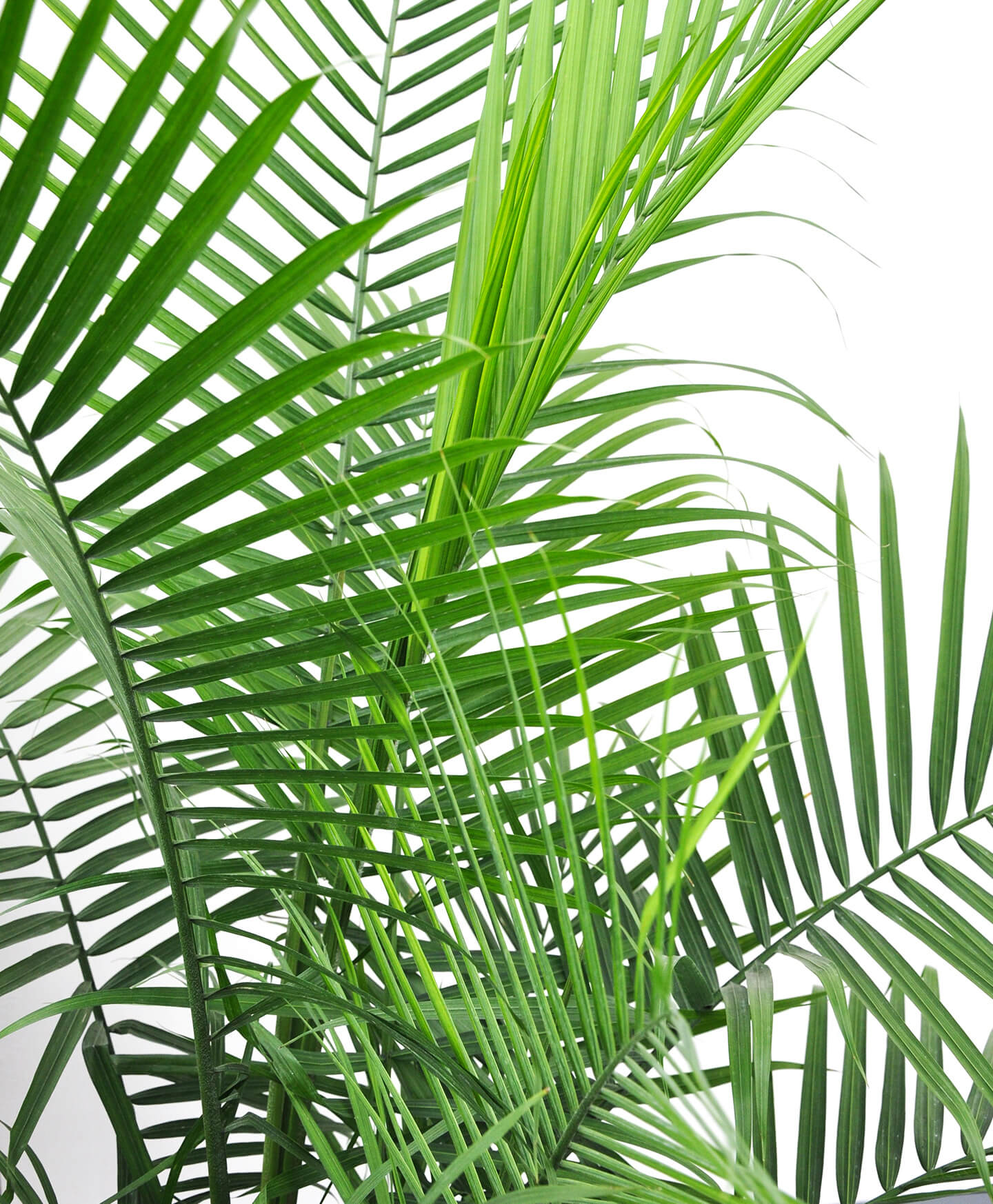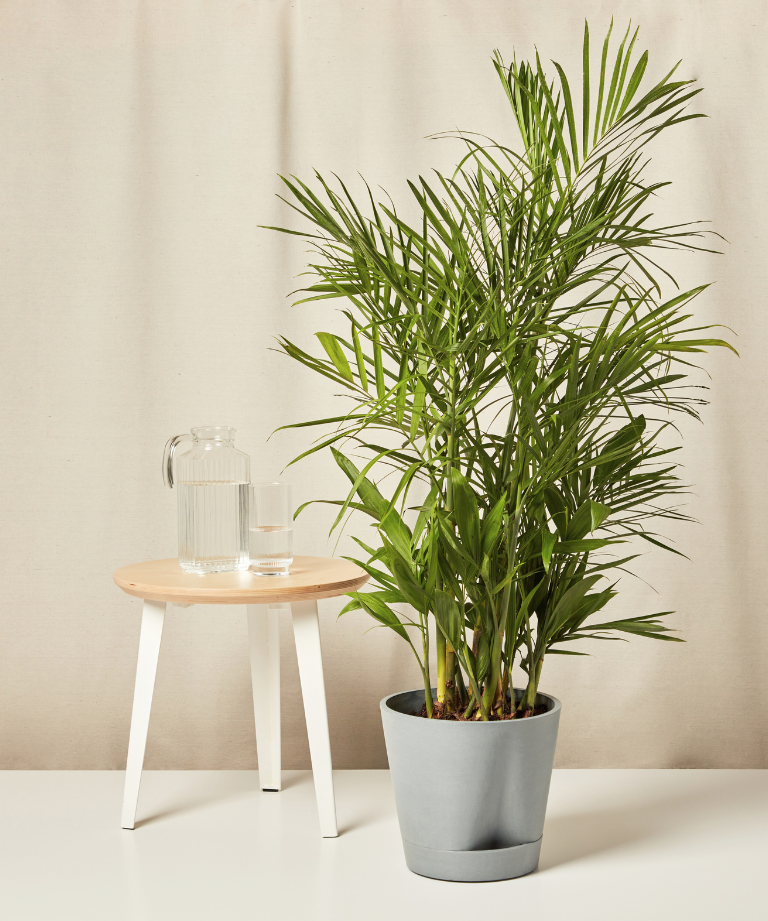Having brown leaves on your indoor palm tree can be worrying. But don’t panic, as there are several common reasons why palm leaves turn brown, and solutions to fix the problem. This article will provide 13 potential causes and solutions for indoor palm leaves turning brown.
Causes of Brown Leaves on Indoor Palm Trees
Here are the most common reasons indoor palm leaves can turn brown
1. Underwatering
Palm trees need consistently moist soil, so underwatering is a common cause of brown leaves. Check if the soil is dry and the plant is wilted.
2. Overwatering
Too much water leads to root rot, causing brown fronds. Check for soggy soil and soft trunks.
3. Excessive Light
Direct sun can scorch leaves brown Move the palm away from direct light if browning is on one side,
4. Low Humidity
Palms need 40-60% humidity. Low humidity causes leaf edges to dry out and turn brown.
5. Cold Drafts
Palms are tropical plants and don’t tolerate cold well. Keep them away from AC vents, windows and doors in winter.
6. Lack of Nutrients
Deficiencies of nitrogen, potassium magnesium, manganese iron and boron cause yellowing or browning leaves.
7. Fertilizer Burn
Too much fertilizer accumulates in the soil, burning roots and turning tips brown.
8. Diseases
Fungal and bacterial diseases like leaf spot, bud rot and fusarium wilt lead to browning.
9. Pests
Spider mites, mealybugs, scale and aphids suck out sap, causing browning. Check for webs or visible insects.
10. Edema
Excess moisture inside leaves causes bumps, blisters and brown spots on leaf undersides.
11. Tap Water
The salts, chlorine and fluoride in tap water can cause browning leaf tips.
12. Natural Causes
As leaves age and die off, they naturally turn brown and drop off. This is normal.
13. Improper Pruning
Over-pruning stresses the plant, interfering with nutrient transport to leaves.
How To Fix Brown Leaves on Indoor Palm Trees
Based on the cause, here are solutions to fix brown leaves on your indoor palm:
-
For underwatering, soak the soil and water regularly when top inch is dry.
-
For overwatering, allow soil to dry out completely between waterings.
-
Provide bright indirect light if insufficient light is the issue.
-
Use a humidifier, mist leaves or place on pebble tray to increase humidity.
-
Keep palms away from cold drafts and maintain temperatures above 60°F.
-
Apply a fertilizer rich in the deficient nutrient if it is a nutritional issue.
-
Flush soil to remove excess fertilizer salts causing burn. Fertilize less frequently.
-
Isolate and treat disease with fungicide. Improve care to prevent infection.
-
Remove pests with insecticidal soap and keep plant quarantined until infestation clears.
-
Allow soil to dry out completely if edema is the cause.
-
Use distilled or rain water instead of tap water which can cause tip burn.
-
Prune only yellow or brown leaves, not more than 30% at one time.
With proper care, your palm should recover from leaf browning. Monitor your plant and make suitable adjustments to care. Seeking early treatment prevents extensive damage. With a little time and effort, you can get your indoor palm thriving again.

Indoor plants aren’t immune to disease or problems, so tending to leaf browning right away helps ensure the palm returns to health. If you’ve detected brown tips on the leaves of your Palm, here are some reasons why this might be occurring, and some steps to fix it.

Water Frequency
Both too much and too little water will damage palms and will lead to leaf yellowing, and browning.
Most palms prefer to be watered when 50% of their soil volume is dry. Always check the soil before watering to make sure it needs it. Water thoroughly and discard any excess water from the saucer. If you water too often it can lead to yellowing and eventual root rot.
Water Quality
Look out for a common problem called ‘tipping’ when the tips of the leaves dry out and turn brown. The most common cause is tap water, which contains salts, chlorine, fluoride, and other elements that may be harmful in excess. To prevent this, you can use distilled water or rainwater.
You can flush the soil a few times a year if you start to notice salt buildup in the form of a white crust-like cover on the top of the soil. Do this by removing that top later of soil and slowly but generously watering your Palm with about four times your pot’s volume of water. Allow water to completely drain from the pot and empty the saucer of any excess water before placing your Palm back in its place.
Over-Fertilization
Fertilizer replenishes nutrients in the potting soil, but too much fertilizer causes leaf tips to brown and can lead to plant health decline. Fertilize Palms only when they are actively growing in the spring and summer months. Dormant Palms do not need additional fertilizer. Use a fertilizer formulated for palm trees at the rate recommended on the package. Remember: more fertilizer is not necessarily better. Always fertilize on moist soil as doing so on dry soil can burn the roots.
Cold Injury
Palms require warm temperatures to thrive. While indoor plants are usually kept warm, cold damage can still occur. Place plants in areas away from window and door drafts where cold air can cause leaf tip browning. Avoid setting plants so they touch the windows in winter, as leaves touching the glass can freeze and brown. In summer, don’t place directly in the path of an air-conditioning vent.
Natural Browning
Palms replace their leaves throughout the growing season. As a palm tree leaf reaches the end of its natural life, it turns brown–beginning at the tip and continuing until the leaf completely browns and drops off. If only one or two leaves are browning and new foliage continues to grow in, the brown tips are natural and not a cause for concern.
Here’s how to properly trim your plant of any brown tips:
- Gather your supplies. You’ll need a pair of sharp scissors or pruning shears, some rubbing alcohol, and paper towel. (Alcohol wipes that come in a first-aid kit work great!)
- Wipe the blades of your sharp scissors or pruning shears with rubbing alcohol before you begin and between each snip. If you are just removing brown crispy leaves due to aging, lack of moisture, or sunburn spots; moisten the blades with water before cutting–this will help prevent healthy tissue damage.
- Cut leaves that are entirely brown or yellow at the base – near the stem or at the soil. Be sure not to tug the leaves, as this can damage healthy parts of the plant. If only part of the leaf is brown or yellow, remove only the affected area.
Important: Be careful not to remove more than 30% of the entire plant while pruning. You may need to prune in stages to avoid removing too many leaves at once.

2 REASONS Your Areca Palm Leaves Turning Brown // Areca Palm Plant Care
FAQ
What do you do when indoor palm leaves turn brown?
If they’re turning brown because the soil is staying too wet, let it dry more between waterings, and dry all the way to the bottom of the pot, not just the surface of the soil. If they’re turning yellow first, then brown, there’s a good chance the soil is too dry – try watering more, or more often.
How often should I water indoor palms?
Indoor palms generally need watering once every one to three weeks, but the exact frequency depends on factors like the season, humidity, and pot size. During the growing season (spring and summer), palms may need watering more frequently, possibly every 7-10 days, while during the dormant season (fall and winter), watering can be reduced to every 2-3 weeks. Always check the soil moisture before watering;
Should I cut off brown palm leaves?
Yes, you should cut off brown palm leaves. Brown leaves are usually dead and trimming them can improve the appearance of the palm tree and prevent potential issues like disease or pest infestations.
How to save a dying indoor palm plant?
Reviving Dying Palms
When you notice that your palm tree is starting to look unwell, the first step is to check to see if it’s getting adequate water. Ideally, the root ball should be soaked. If it seems okay, trim off all the dead fronds. If you have the ability, we suggest you treat the palm with a fungicidal drench.
